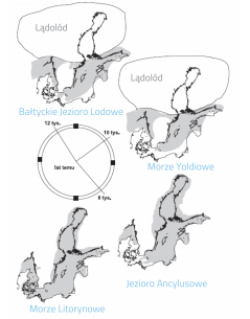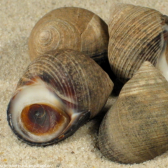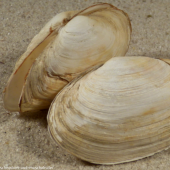
History of the Baltic Sea
History of the Baltic
Imagine a forest, dominated by pine trees, but there are also deciduous trees such as maples, sandalwood and laurel trees, palm trees. Huge lakes and a powerful river. Amazing variety of animals and plants. This is what the area that today covers the Baltic Sea looked like more than 40 million years ago. However, its story begins much later, in much colder times…
These dense forests disappeared about a million years ago, when the climate had begun to cool down and a glacier was formed from masses of snow. This glacier was 3 000 m thick and moved back to the area occupied today by the Baltic Sea and to the north (glacial and interglacial periods). As the glacier moved to the north, the areas uncovered by it filled in with seas and lakes. We do not know much about them, but probably their history was much longer than the history of the Baltic itself. It is interesting to know that the Eem Sea was most likely a warm sea and had a connection with the Atlantic and the White Sea.
The last glacial period ended about 16 thousand years ago and the history of the Baltic has begun 13 thousand years ago, after the complete disappearance of the glacier.
As the glacier moved to the north, small lakes were formed and are nowadays known as the Baltic Ice Lakes. At that time, the cold climate prevailed, so periodically they were covered with ice. Then, about 12 thousand years ago, they merged to form the Baltic Ice Lake, still bounded by an ice cover on the north. This lake existed for about thousand years and its level was 20 metres higher than the ocean level at that time and 50 metres lower than the sea level. Due to the cold climate, life in this lake was relatively rare, and the fauna and flora consisted mainly of freshwater species.
The next stage in the history of the Baltic occurred very abruptly. The ice bridge linking the Baltic Ice Lake and the ocean broke. The water level dropped by 26 metres, and the connection with the Atlantic caused an inflow of saline water. The Yioldia Sea was formed. The name of the sea is adapted from the name of the bivalve, Yoldia arctica (now known as Portlandia arctica). It was characteristic for this basin to have salinity zones.
The warming of the climate was causing a complete disappearance of the glacier. This accelerated the isostatic movements and the strait connecting the Yoldia Sea with the ocean became shallow. Smaller inflows of saline water caused the formation of another stage in the Baltic history, called the Ancylus Lake. The name comes from the widespread occurrence of a snail of the Ancylus fluviatilis species. The level of water increased as a result of the inflow from many rivers, causing the waters of the lake to flow to the North Sea.
About 8 thousand years ago, as a result of rising level of the North Sea, saline waters began to enter the lake through the Danish straits. The lake transformed into a sea with a salinity of 15 PSU, called the Littorina Sea, after the snail Littorina littorea. This sea had higher salinity, was bigger and warmer and its surface was 4 metres higher than the Baltic Sea.
The Baltic as we know it today was created as a result of the connection with the ocean becoming shallow and thus the inflow of ocean waters was less abundant. The current chapter in the history of the Baltic has been going on for the last 2.5 thousand years and is called the Mya Sea, after the mussel Mya arenaria, which was brought on the ships from South America around the 16th/17th century. The shells of this mussel can still be found at the Baltic coast.





